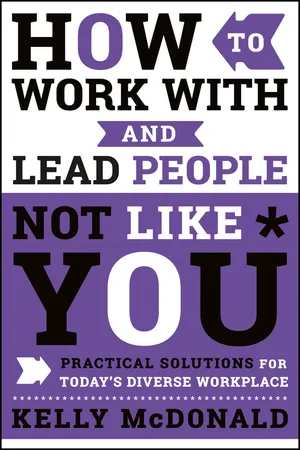
How to Work With and Lead People Not Like You
Practical Solutions for Today's Diverse Workplace
- English
- ePUB (mobile friendly)
- Available on iOS & Android
How to Work With and Lead People Not Like You
Practical Solutions for Today's Diverse Workplace
About this book
If you're in a diverse team, you know employee differences can cause miscommunication, lower trust, and hurt productivity... It doesn't have to be this way!
The people you work with may be from a different generation, different culture, different race, different gender, or just a different philosophy toward work and life in general, but you need to work together toward a common goal. How to Work With and Lead People Not Like You explains how to dial down the differences, smooth out the friction, and play upon each other's strengths to become more effective, more productive, and less stressed. The keys are to find the common ground and identify hidden conflicts that are hurting productivity.
Many people shudder at the prospect of working with diverse groups of people, but they can't voice their fear or anxiety. At work, it's not OK or politically correct to say, 'I'm uncomfortable with this person.' In fact, if you do say something along those lines, your job may be at risk. Your company may terminate you for not being on the 'diversity bandwagon.' So you keep quiet and you keep your thoughts to yourself. But deep down, you are uncomfortable.
If you feel like this, it doesn't mean you're racist, sexist, ageist, homophobic, or any other negative label. It means you're struggling.
You're struggling to understand people, cultures, or values that are unfamiliar to you. You're struggling to do your job with teammates and coworkers who may have very different viewpoints or different approaches to communication than you have. You're struggling to overcome differences and pull together to achieve high performance at work.
Whether you're leading a diverse team, working in a challenging cross-cultural environment, or simply working with people who are 'not like you, ' you need to be able to get along with everyone as a team, to get the work done. This book explains the skills you need to communicate, motivate, and inspire people to collaborate—even if they have very different values, lifestyles, or priorities.
- Learn key steps that bring cohesion to diversity
- How to have a constructive conversation about working alongside people who are different
- The four magic words that make this easier and smooth over friction
- What not to say—and why
- Learn to set aside differences and get things done
- Learn how to handle a racist, sexist, homophobic or offensive remark in a professional way
- Retain your sanity when colleagues drive you crazy
The changing demographics of today's workforce bring conflicting viewpoints, perspectives, approaches, skills, habits, and personalities together in one place; whether that leads to synergy or catastrophe is up to you. How to Work With and Lead People Not Like You helps you turn a hurdle into an advantage so you or your team can do more, achieve more, and enjoy the ride.
Frequently asked questions
- Essential is ideal for learners and professionals who enjoy exploring a wide range of subjects. Access the Essential Library with 800,000+ trusted titles and best-sellers across business, personal growth, and the humanities. Includes unlimited reading time and Standard Read Aloud voice.
- Complete: Perfect for advanced learners and researchers needing full, unrestricted access. Unlock 1.4M+ books across hundreds of subjects, including academic and specialized titles. The Complete Plan also includes advanced features like Premium Read Aloud and Research Assistant.
Please note we cannot support devices running on iOS 13 and Android 7 or earlier. Learn more about using the app.
Information
PART I
Working with People Not Like You: How to Build Relationships and Foster Connections across Different Cultures and Values
CHAPTER 1
“I Used to Just Be Able to Do My Job—Now I Have to Be Politically Correct”
DIVERSITY FATIGUE—WHY PEOPLE ROLL THEIR EYES WHEN THEY HEAR THE WORD “DIVERSITY”
THE NEW DEMOGRAPHICS
- Different racial and ethnic groups
- Black, White, Asian, Native American, Pacific Islander, Hispanic/Latino, Middle Eastern, South Asian (Indian, Pakistani, etc.)
- Different religious groups and views
- Men and women
- Different ages and generations
- LGBTQ (lesbian, gay, bisexual, transgender, and questioning—“questioning” includes those who may be unsure of their sexual orientation or preference, such as teens who are still developing and exploring, or those for whom sexuality and/or gender identity is more fluid)
- Introverts and extroverts
- Marital status (single, married, divorced, partnered, widowed)
- Parents and nonparents
- And within “parents,” there is no doubt that single parents have different lives and demands on them than two‐parent households
- Different levels of income and affluence
- Differing political views
- Different education levels
- Different cultural backgrounds—this would include different heritage, traditions, and customs, but can also include things that shape culture significantly. Examples of these include:
- Military versus civilian backgrounds/experience
- Rural versus metropolitan backgrounds
- North/South or East Coast/West Coast backgrounds
- White‐collar versus blue‐collar professions
- Differing physical, emotional and mental abilities
- Full‐time versus part‐time workers and “gig” workers
- Office workers versus telecommuters
- In some companies and organizations, the flexibili...
Table of contents
- Cover
- Title Page
- Table of Contents
- Acknowledgments
- PART I: Working with People Not Like You: How to Build Relationships and Foster Connections across Different Cultures and Values
- PART II: Leading People Not Like You—How to Get a Diverse Group of People to Trust Each Other and Work Together
- Conclusion
- Index
- End User License Agreement